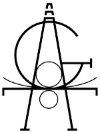Guttenberg NJ (March 28th), Guttenberg Arts Gallery is pleased to present “MADE HERE Winter 2017” a group exhibition of the current Artists in Residence; Milcah Bassel, Joseph Martin Gabriel, Ryan Schroeder and Jeremy Coleman Smith. On view April 7 - May 26, 2017. The works included in MADE HERE were created during the artist’s residences this past winter. The title “MADE HERE” carries not only multiple definitions, but multiple conceptual meanings ranging from location to identity, the politics of materials and the historical nature of place. All of these new works deeply considered many of these issues and are only just the beginning points for deeper reflection.
Milcah Bassel’s newest work incorporates traditional printmaking and ceramics, employing abstract geometric forms as compartments of body interiors and exploring the perpetual human need to measure and quantify the organic world. Like her previous performative time-lapse sequence “Grid Piece”, the work created at Guttenberg Arts continues to explore the phenomenology of spatial relations, questioning where experience and imagery converge and crossover. This new body of work continues to spins poetic, whimsical and philosophical perspectives on themes enhanced by Bassel’s intersection of clay and paper, which generates a complex dialogue between dimensions both literally and metaphorically.
Joseph Martin Gabriel’s current work draws upon the boundaries and subtle nuances between what we regard as natural and artificial. During his time at Guttenberg Arts, Gabriel experimented with collages, drawings, lithographs and ceramics resulting in numerous visual hybrids derived from contrasting urban horticultural elements and imagined natural forms. Gabriel’s works generate emphasis between fragile and rigid; familiar and uncanny; concrete and liminal. Most of his works reflect on this idea of existence and ephemerality where a simultaneous tension is created between something that exudes life and something that shows the lack or absence thereof.
Ryan Schroeder’s large scale oil paintings are relics that reflect reality. Through paint, Schroeder explores space as a phenomenological experience in that the subject matter is assembled through firsthand experience. His primary focus is finding a means to transmit the dominant psychological feeling of a place visually. His attraction to spaces that possess a residue of occupation and visceral sensation of human presence was amply met during his time at Guttenberg Arts. Working in New Jersey allowed Schroeder to continue his exploration of the historic significance of industry in terms of its impact on avant-garde culture. His latest work features the structures and framework of Guttenberg Arts studio space (formerly a textile factory then dental foundry turned artist space). Like previous paintings, this body of work evokes contemplation of the human factor and explores the aftermath of industrial developments.
Jeremy Coleman Smith’s work continues to investigate the relationship between people, objects of display and the interior spaces where they interact. Smith believes that in an effort to describe ourselves, we adorn our personal spaces and develop an image of self through the contents we choose to display in a room. The presentation of these objects helps fabricate an image of the occupant and becomes a depiction of self-narrative. Smith’s work questions what we cherish more, the image of the object, the idea of the experience or the object itself. In his recent work, Smith has been exploring textures of textiles and other materials within a domestic setting. He has recreated these scenes out of paper, cardboard and styrofoam in combination with various printmaking techniques. Throughlarge copper plate etching and photographic imagery, Smith used computer-generated, photographic patterning to create seamless images as it is printed onto long rolls of paper, ergo creating his own unique paper upholstery. Further exploration during his fellowship included the transfer of photographic images onto copper by silkscreening directly onto the plate with a sugar lift solution. In addition Smith enhanced these images with other aquatint techniques.

